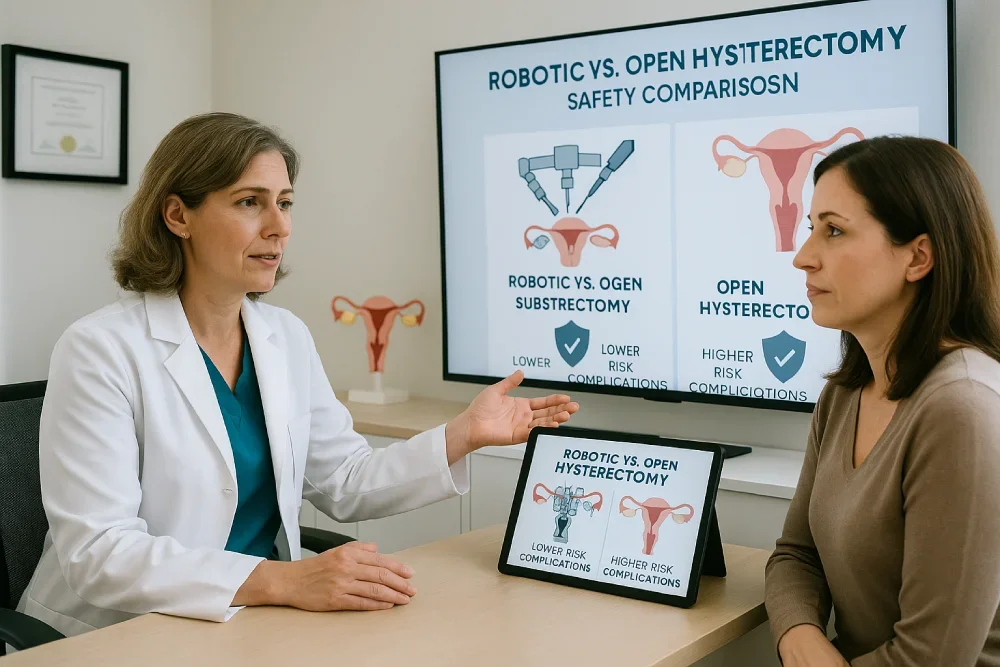Robotic vs Open Hysterectomy: Which Is Safer?
Categories:
By: Ethan Cole
Robotic hysterectomy is a safe and effective surgical option for many patients, including those with complex cases such as large uteri or high BMI. A 10-year retrospective study of 495 robotic hysterectomies found reduced blood loss and shorter operating room times with experienced surgeons, even as case complexity increased.
The robotic approach has contributed to a significant decline in open abdominal hysterectomies, shifting complex surgeries toward minimally invasive techniques. While initial hospital stays were longer in some systems due to local care standards, overall robotic surgery reduces complications, postoperative pain, and recovery time compared to open surgery. These findings support robotic hysterectomy as a minimally invasive option that enhances patient outcomes in benign gynecologic surgery.
Key Takeaways
Robotic hysterectomy is safer than open surgery for patients with large uteri, high BMI, or complex pelvic pathology, offering less blood loss and fewer complications.
Complication and mortality rates are significantly lower with robotic procedures compared to open hysterectomy, while long-term readmission and reoperation rates are similar.
Hospital stays are much shorter with robotic surgery (≈1 day) versus open procedures (2–3+ days), contributing to faster patient recovery and reduced healthcare burden.
Postoperative pain is lower with robotic hysterectomy due to smaller incisions and reduced tissue trauma, often requiring fewer opioids during recovery.
Costs are higher upfront for robotic surgery due to equipment and operating room time, but faster recovery may reduce indirect costs like missed work and caregiving.
Surgeon experience is critical—greater expertise improves safety, reduces operative time, and expands minimally invasive options for complex gynecologic cases.
Recovery After Robotic Hysterectomy
Robotic hysterectomy patients typically experience a faster and less painful recovery compared to open hysterectomy. Most patients are discharged within 24 hours, with many able to go home the same day after surgery. The smaller incisions used in robotic procedures result in minimal scarring and reduced tissue trauma, which helps lessen post-operative pain and shortens hospital stays.
Full recovery usually takes about three to four weeks, during which light activities can be resumed within a few days. Patients are advised to avoid heavy lifting and strenuous activity for about six weeks to allow proper healing. Pain management is generally easier with robotic surgery due to less initial discomfort, and patients often require fewer opioid medications. Most people can return to work within two to three weeks, depending on the nature of their job.
This accelerated recovery timeline and reduced post-surgical pain make robotic hysterectomy a preferred choice for many seeking minimally invasive gynecologic surgery.
What Is an Open Hysterectomy?
Definition and Overview
An open hysterectomy, also called an abdominal hysterectomy, is a surgical procedure where the uterus is removed through a larger incision in the lower abdomen. This traditional method involves the surgeon making a vertical or horizontal cut to access the uterus for removal. The surgery ends the menstrual cycle and the ability to become pregnant.
How It Is Performed
The surgeon makes a 5-7 inch incision in the abdomen, either vertically or horizontally based on medical necessity.
The uterus is detached from the fallopian tubes, ovaries, and upper vagina and removed through the incision.
The procedure typically lasts about 1-2 hours under general or regional anesthesia.
After removing the uterus, the incision is closed with sutures or staples.
Recovery Process
Hospital stay is usually 2-3 days following surgery.
Postoperative pain and a larger scar are common due to the size of the incision.
Full recovery and return to normal activities typically take 4-6 weeks.
Patients may experience bleeding and need to avoid heavy lifting during recovery.
When Is Open Hysterectomy Recommended?
For very large uteri that cannot be removed vaginally or laparoscopically.
When additional pelvic organs need examination or intervention.
When minimally invasive surgery is not possible due to medical or anatomical reasons.
This method remains common for complex cases but involves longer recovery and more risks compared to minimally invasive hysterectomies.
Safety Comparison: Robotic vs Open Hysterectomy
Robotic hysterectomy has been shown to provide significant safety benefits compared to open hysterectomy, especially regarding blood loss, complications, and hospital stay length.
Robotic surgery typically leads to less blood loss during the procedure. Multiple large-scale studies and meta-analyses found that the average estimated blood loss (EBL) with robotic hysterectomy is significantly lower than with open abdominal hysterectomy, reducing the need for blood transfusions.
In terms of complications, robotic hysterectomy is associated with fewer intraoperative and postoperative complications. The risk of mortality is also lower with robotic-assisted surgery compared to open surgery.
Hospital stays after robotic hysterectomy tend to be shorter, often around one day, whereas open surgery patients frequently require multiple days of inpatient care.
While robotic surgery may take longer to perform initially due to setup and learning curve factors, increased surgeon experience has been shown to reduce operative times, balancing the trade-offs.
Readmission and reoperation rates do not differ significantly between robotic and open approaches, indicating comparable long-term safety.
Robotic vs Open Hysterectomy Safety and Recovery
|
Factor |
Robotic Hysterectomy |
Open Hysterectomy |
|
Estimated Blood Loss |
Significantly lower |
Higher |
|
Risk of Intraoperative Complications |
Lower |
Higher |
|
Risk of Postoperative Complications |
Lower |
Higher |
|
Mortality Risk |
Lower |
Higher |
|
Average Hospital Stay Length |
Typically 1 day |
2-3+ days |
|
Operative Time |
Longer initially but decreases with experience |
Generally shorter |
|
Readmission Rate |
Comparable |
Comparable |
|
Reoperation Rate |
Comparable |
Comparable |
These data affirm that robotic hysterectomy offers improved safety outcomes and faster recovery compared to open hysterectomy, particularly for benign uterine conditions and complex cases requiring minimally invasive techniques.
Candidate Criteria for Robotic vs Open Hysterectomy
Choosing between robotic and open hysterectomy depends largely on patient-specific factors and the complexity of the case.
Who Is a Candidate for Robotic Hysterectomy?
Robotic hysterectomy is suitable for many patients needing hysterectomy for benign gynecologic conditions. Ideal candidates typically:
Have no contraindications to general anesthesia or laparoscopic surgery (e.g., severe cardiopulmonary disease).
Do not have extensive pelvic adhesions or fixed uterus.
Have uterine size within operable limits for minimally invasive surgery (although robotic surgery can manage larger uteri better than traditional laparoscopy).
May have obesity (BMI > 30), as robotic surgery offers better ergonomics and visualization in these cases.
May have complex surgical pathology such as advanced endometriosis or prior pelvic surgeries, which would increase laparoscopic technical difficulty.
Require concurrent procedures (e.g., lymphadenectomy in cancer cases) that can be facilitated robotically.
Benefit from minimally invasive advantages such as reduced pain, faster recovery, and shorter hospital stay.
Extensive evidence shows robotic hysterectomy particularly benefits patients with high surgical complexity or obesity, where conventional laparoscopic hysterectomy may be challenging.
Who May Require Open Hysterectomy?
Open hysterectomy remains necessary for patients with:
Very large uterine size or significant pelvic mass that cannot be safely removed minimally invasively.
Suspicion or diagnosis of advanced malignancy requiring extensive surgical staging.
Severe adhesions or anatomic abnormalities preventing minimally invasive access.
Emergency surgical cases where rapid access is required.
Patients for whom robotic or laparoscopic surgery is contraindicated medically or technically.
The obstetrician-gynecologist's judgment, surgical expertise, patient anatomy, comorbidities, and patient preference all guide selecting the safest and most effective surgical approach.
Costs and Accessibility of Robotic vs Open Hysterectomy
Robotic hysterectomy is generally more expensive than open hysterectomy upfront due to the high costs of robotic equipment, maintenance, and longer operating room time. Studies show that the average patient cost for robotic hysterectomy ranges higher than for open surgery when looking at direct hospital charges.
However, when accounting for the shorter hospital stay, faster recovery, and quicker return to work associated with robotic surgery, the overall societal costs may be lower or comparable. Indirect savings, such as reduced lost wages and caregiver needs during recovery, can offset the higher operative expenses of robotics.
Open hysterectomy typically involves longer inpatient stays and recovery periods, which contribute to increased total healthcare costs beyond the initial surgery charge.
Access to robotic surgery depends on hospital resources and surgeon expertise. Robotic hysterectomy tends to be available primarily at larger medical centers equipped with the robotic systems and trained professionals. In regions or facilities lacking this technology or expertise, open hysterectomy remains the more accessible option.
In summary, robotic hysterectomy carries higher initial procedural costs, but its minimally invasive advantages may produce overall economic benefits by reducing recovery-related expenses and improving patient outcomes.
Availability and cost considerations should be discussed with healthcare providers when deciding the best surgical approach.
Conclusion
Robotic hysterectomy offers significant benefits over open hysterectomy, including less blood loss, fewer complications, shorter hospital stays, and faster recovery, making it a safer and more patient-friendly option. While operative times may be longer initially, surgeon experience can reduce this difference. For obstetrician-gynecologists (obgyn), robotic surgery expands minimally invasive options to complex cases previously requiring open procedures.
This approach optimizes patient outcomes while minimizing surgical trauma. Ultimately, robotic hysterectomy represents a valuable technique in gynecologic surgery, providing enhanced safety and recovery benefits compared to the traditional open approach.
Find out if robotic hysterectomy is the safest option for your needs. Schedule a consultation with Dr. Jason Neef today to review your surgical choices and recovery expectations.
Find out if robotic hysterectomy is right for you.
Call (817) 568-8731Categories:
Frequently Asked Questions
-
Robotic hysterectomy is safer for patients with benign gynecologic conditions, large uteri, obesity, and complex pelvic pathology, offering less blood loss and fewer complications compared to open surgery.
-
Robotic hysterectomy has significantly lower intraoperative and postoperative complication rates, including reduced mortality risk, compared to open hysterectomy.
-
Obesity increases surgical difficulty; robotic surgery provides improved visualization and access, reducing blood loss and complications compared to open surgery in obese patients.
-
Long-term outcomes such as readmission and reoperation rates are comparable between robotic and open hysterectomy, with robotic surgery offering faster recovery.
-
Robotic hysterectomy incurs higher upfront costs but may lower overall costs due to shorter hospital stays and faster recovery compared to open surgery.
-
Robotic hysterectomy patients usually stay about 1 day, while open surgery patients stay 2-3 or more days.
-
Robotic procedures take longer initially due to setup but decrease with experience; open surgery is usually faster.
-
Yes, robotic hysterectomy is effective and safe for very large uteri, sometimes outperforming open surgery in recovery and complication rates.
-
Patients generally experience less postoperative pain after robotic surgery versus open hysterectomy.
-
Yes, surgeon experience reduces operative time and improves outcomes, making robotic hysterectomy safer over time.












